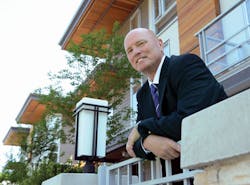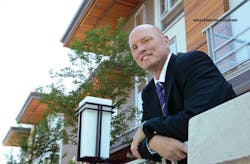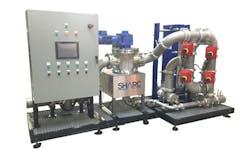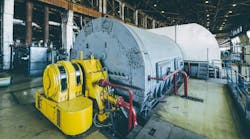The wastewater industry has long been aware of the abundant energy available in wastewater - and sought ways to unlock this potential. Now, a Canadian company has developed two innovative technologies to recover the thermal energy in sewage and wastewater - and has successfully installed them at a variety of locations.
By Andrew Williams
Due to its very nature, wastewater contains a fair amount of latent warmth - and stakeholders across the industry have long pondered about the most effective way to extract this heat and convert it to energy for other uses.
One company may well have found the answer. Vancouver-based company International Wastewater Systems (IWS) has developed not one but two sewage heat recovery technologies that it claims can be used at scales ranging from a single building to an entire city.
Feeding The SHARC
The first technology, called the SHARC Energy Recovery System - or the Sewage SHARC - is a filtration system for raw sewage. It works by employing a filtration and screening process to separate the solid and water content of sewage to enable extraction of the latent heat contained in the sewage water, which is then used to drive heat pumps.
This allows operators to use proprietary plate heat exchangers and heat pumps to raise the temperature of the water to facilitate the production of domestic hot water and space heating and cooling for buildings. The SHARC can also be used to save energy and water usage by eliminating the need for a cooling tower for air conditioning operation.
According to Russ Burton, CEO at SHARC Energy Systems - a wholly owned subsidiary of IWS - the Sewage SHARC can recover waste energy at efficiencies of up to 400% using existing heat pump technology, helping to make the use of wastewater as a regenerative energy source cost effective, as well as efficient and stable.
Year Round Energy Source
With a consistent temperature of around 21°C (77°F) when exiting buildings, Burton also explains that wastewater provides an “all year round energy source” that facilitates higher heat pump efficiencies than other regenerative sources used alongside heat pump technology - including air source, ground source and open water source systems.
“The SHARC heat recovery system can be used in both the winter, for space and domestic water heating, as well as in summer for efficient operation of air conditioning systems,” he adds.
The company also manufactures a smaller version of the SHARC system, called the Piranha, which is used primarily to recover the thermal energy in used domestic hot water - and to heat fresh hot water elsewhere in a building - as part of a continuous loop.
Here, the thermal energy in used hot water that would otherwise have been wasted down the drains is recovered by the Piranha and transferred back into the next domestic hot water system ready for reuse.
Once the energy cycle in a building commences, the same energy is used and re-used every day - and all the building occupants pay for is the energy it takes to move the energy from the waste flow back into the hot water tanks.
Market Opportunity
As Lynn Mueller, president and CEO at IWS, explains, the company was formed six years ago with the chief aim of “recovering the waste heat that is put down drains around the world”.
The potential size of the market, which Mueller estimates as “a $35 billion opportunity for IWS to recover and reuse that energy in the US alone,” also convinced the team at IWS that this was a sector worth entering.
“The US Department of Energy had released a study showing that 350 billion kilowatts of energy flows down the drains every year in the US from household uses like showering, laundry, dishwashing and other household uses.
“The rest of the world also has similar water usage numbers - meaning that 25 to 30% of energy used by buildings ends up being wasted down the drains and eventually ending up in rivers and oceans - so the opportunity is enormous,” says Mueller.
The company officially went public on the Canadian exchange, Symbol IWS, in October 2015. Since its creation, the technology has been installed and operated at several locations in British Columbia and Washington State - including at the Gateway Theatre in Richmond BC and the Sail Apartments at the University of British Columbia, as well as at the Sechelt Wastewater treatment works.
“In all of these cases, the system has been operating consistently for between three and five years and has exceeded the predicted energy production and carbon saving targets,” the CEO adds enthusiastically.
Scottish Installation
The company has also recently completed the installation of a fully functioning system in Scotland. Here, wastewater from a sewer near to a local treatment works operated by utility Scottish Water is intercepted and used to power a heating system at the Borders College Campus in Galashiels under a 20-year purchase agreement.
The installation, which was supported in June 2015 by a £4 million investment from the UK Green Investment Bank (GIB) and Equitix, now generates some 95% of the heat needed by the Galashiels campus without affecting the day to day operation of the local wastewater network.
At least as far as the UK is concerned, Burton agrees that a major challenge lies in the “communication and education of customers” - particularly in view of the fact that he says the country is “chronically short of suitably qualified engineers with heat pump knowledge and the confidence to adopt heat pumps as a principle technology over traditional fossil fuel burning equipment”.
“We think the best way to overcome this challenge is to de-risk the clients exposure and provide a full design, build, finance and operate service that leaves us with the responsibility of ensuring the equipment functions and does what we claim,” he adds.
Further UK Roll Out
Looking ahead, Burton says that the company has bold plans for the future commercial roll out of the system and, although coy about the exact details, reveals that it is in advanced discussions with two UK water companies to develop partnerships to deploy its equipment across their sewer network.
The company is now “looking more widely for distributor arrangements on the European continent”. Mueller adds that IWS is now operating worldwide with a fully staffed office in the UK and sales representation in most of the rest of the world - and has a “very aggressive” expansion plan to solidify its position as “clear world leaders in the sewage heat technology industry.”
Andrew Williams is a freelance contributor for WWi magazine, based in the UK.
More Water & WasteWater International Archives Issue Articles




